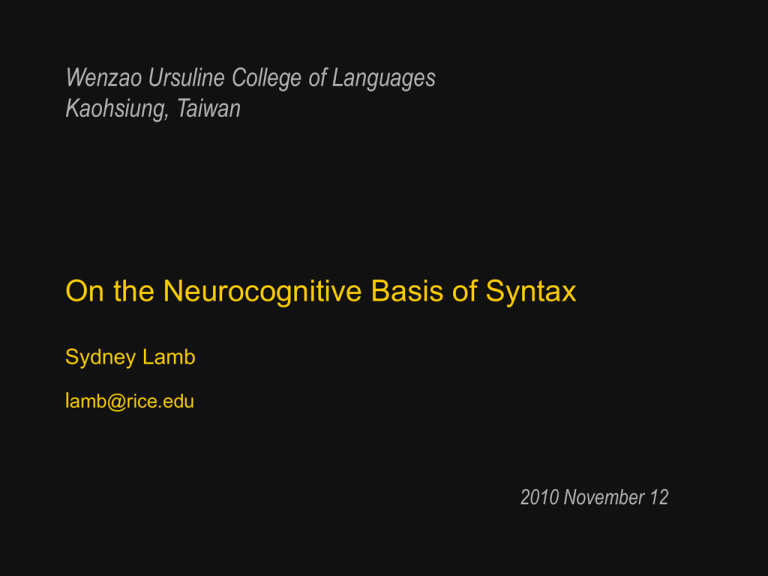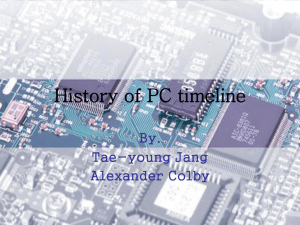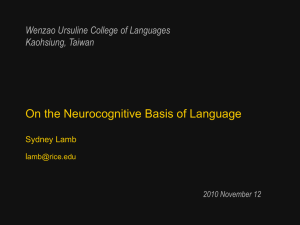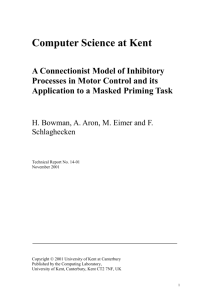Syntax in the Brain
advertisement

Wenzao Ursuline College of Languages Kaohsiung, Taiwan On the Neurocognitive Basis of Syntax Sydney Lamb lamb@rice.edu 2010 November 12 Why is it important to consider the brain? “I gather…that the status of linguistic theories continues to be a difficult problem. … I would wish, cautiously, to make the suggestion, that perhaps a further touchstone may be added: to what esxtent does the throry tie in with other, non-linguistic information, for example, the anatomical aspects of language? In the end such bridges link a theory to the broader body of scientific knowledge.” Norman Geschwind “The development of the brain and the evolution of language” Georgetown Round Table on Languages and Linguistics, 1964 The two big problems of neurosyntax How does the brain handle.. Sequencing – ordering of words in a sentence 1. And ordering of phonemes in a word – 2. Categories – Noun, Verb, Preposition, etc. • Subtypes of nouns, verbs, etc. – – – – What categories are actually used in syntax? How are syntactic categories defined? How represented in the brain? How does a child build up knowledge of such categories based on just his/her ordinary language experience? First step: accounting for sequence • Important not just for language – Dancing – Eating a meal – Events of the day, of the year, etc. – Etc., etc. • In language, not just syntax (lexotactics) – Ordering of morphemes in a word • Morphotactics – Ordering of phonological elements in syllables • Phonotactics – Ordering of sememes in a thought Neurological Structures for Sequence • How is sequencing implemented in neural structure? • For an answer, consider the structure of the cortical column Lasting activation in minicolumn Cell Types Recurrent axon branches keep activation alive in the column – Until is is turned off by inhibitory cell Pyramidal Spiny Stellate Inhibitory Connections to neighboring columns not shown Subcortical locations The ‘Wait’ Element 1 2 www.ruf.rice.edu/~lngbrain/neel Lasting activation in minicolumn Cell Types Recurrent axon branches keep activation alive in the column – Until is is turned off by inhibitory cell Pyramidal Spiny Stellate Inhibitory Connections to neighboring columns not shown Subcortical locations Simple notation for lasting activation Thick border for a node that stays active for a relatively long time Thin border for a node that stays active for a relatively short time N.B.: Nodes are implemented as cortical columns Recognizing items in sequence This link stays active This node recognizes the sequence ab c a b Node c is satisfied by activation from both a and b If satisfied it sends activation to output connections Node a keeps itself active for a while Suppose that node b is activated after node a Then c will recognize the sequence ab Example: eat apple (structure for recognition) (Just labels, not part of the structure) eat apple eat apple Example: eat apple, eat banana (structure for recognition) eat apple eat apple eat banana banana Producing items in sequence Wait element ab a b First a, then b How does the delay element work? • Remember: each node is implemented as a cortical column – Within the column are 75-110 neurons • Enough for considerable internal structure • When node ab receives activation, it – Sends activation on down to node a – And to the delay element, which • Waits for activation from clock timer or feedback – Will come in on line labeled ‘f’ in diagram • Upon receiving this signal, sends activation on to node b Producing items in sequence Delay element ab a f b Carries feedback or clock signal Producing items in sequence May be within one cortical column ab a f b Producing items in sequence a different means a b f This would apply for items ‘a’ and ‘b’ in sequence where there is no ‘ab’ to be recognized as a unit. Example: Adjectives of size precede adjectives of color, which precede adjectives of material in the English noun phrase, as in big brown wooden box Two different network notations Narrow notation • • • • Nodes represent cortical columns Links represent neural fibers Uni-directional Close to neurological structure eat apple eat apple Abstract notation • • • • Nodes show type of relationship (OR, AND) Easier for representing linguistic relationships Bidirectional Not as close to neurological structure eat apple eat apple Two different network notations Narrow notation b a ab Upward b f a ab Abstract notation Bidirectional a b Downward b Constructions have meanings and functions • They are also signs Meaning/Function Form/Expression The sign relationship: a (neural) connection The difference is that for a construction the expression is variable rather than fixed The transitive verb phrase construction Semantic function Syntactic function CLAUSE DO-TO-SMTHG Transitive verb phrase Variable expression Vt NP Linked constructions The clause construction CL DO-TO-SMTHG NP Transitive verb phrase Vt NP Add a few more connections ACTOR-DO CL DO-TO-SMTHG Transitive verb phrase Vt NP Add other types of predicate THING-DESCR CL BE-SMTHG DO-TO-SMTHG Vi (A rough first approximation) Vt be Adj NP Loc The other big problem for syntax • Categories • Problems of categories are considered in a separate presentation – “Categories in the Brain” • Lexotactics uses very broad categories – We can say, e.g., “tried to eat a truck” • For narrower categories, Semotactics – So the prototypical goals of EAT are edible objects






